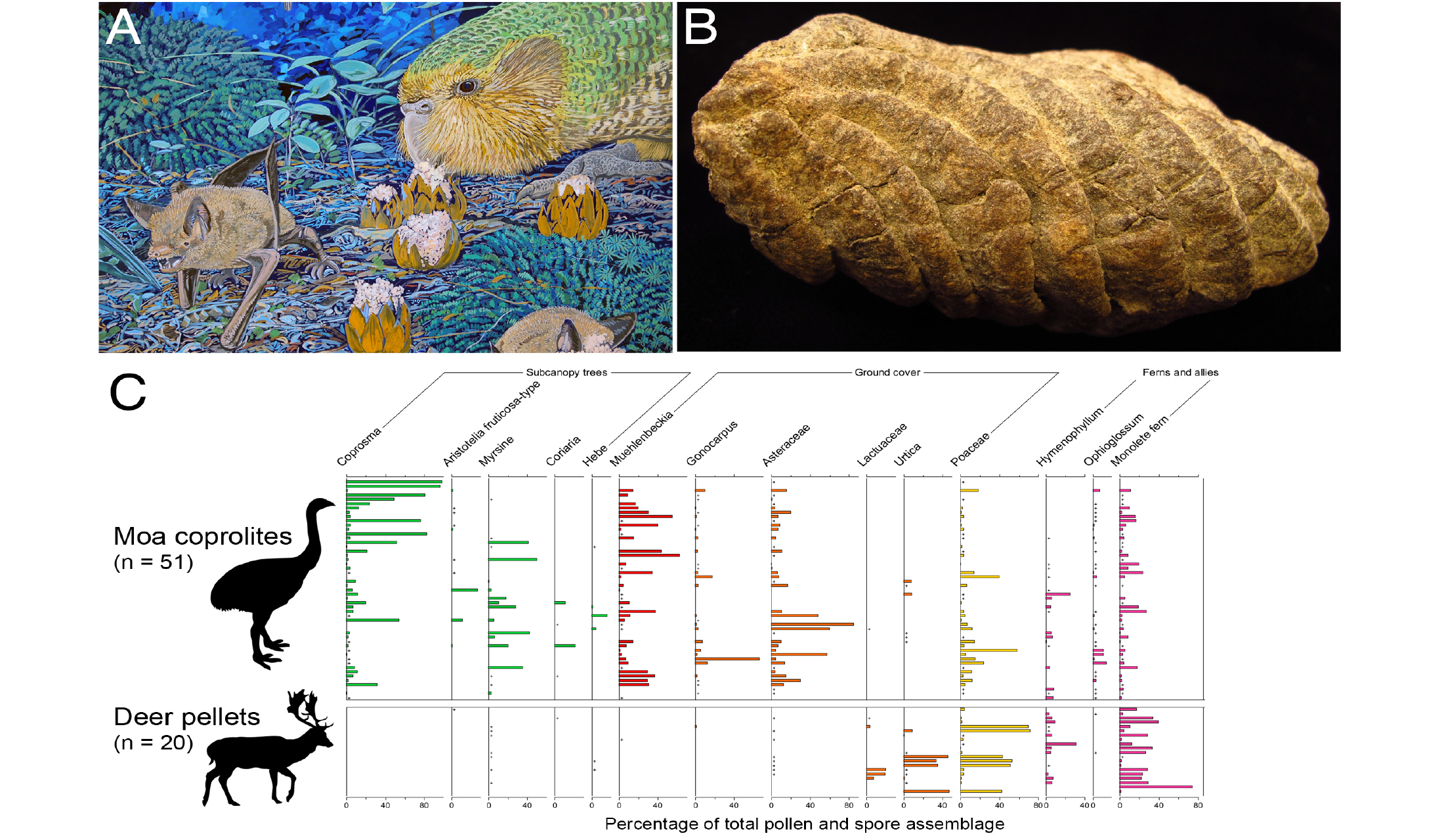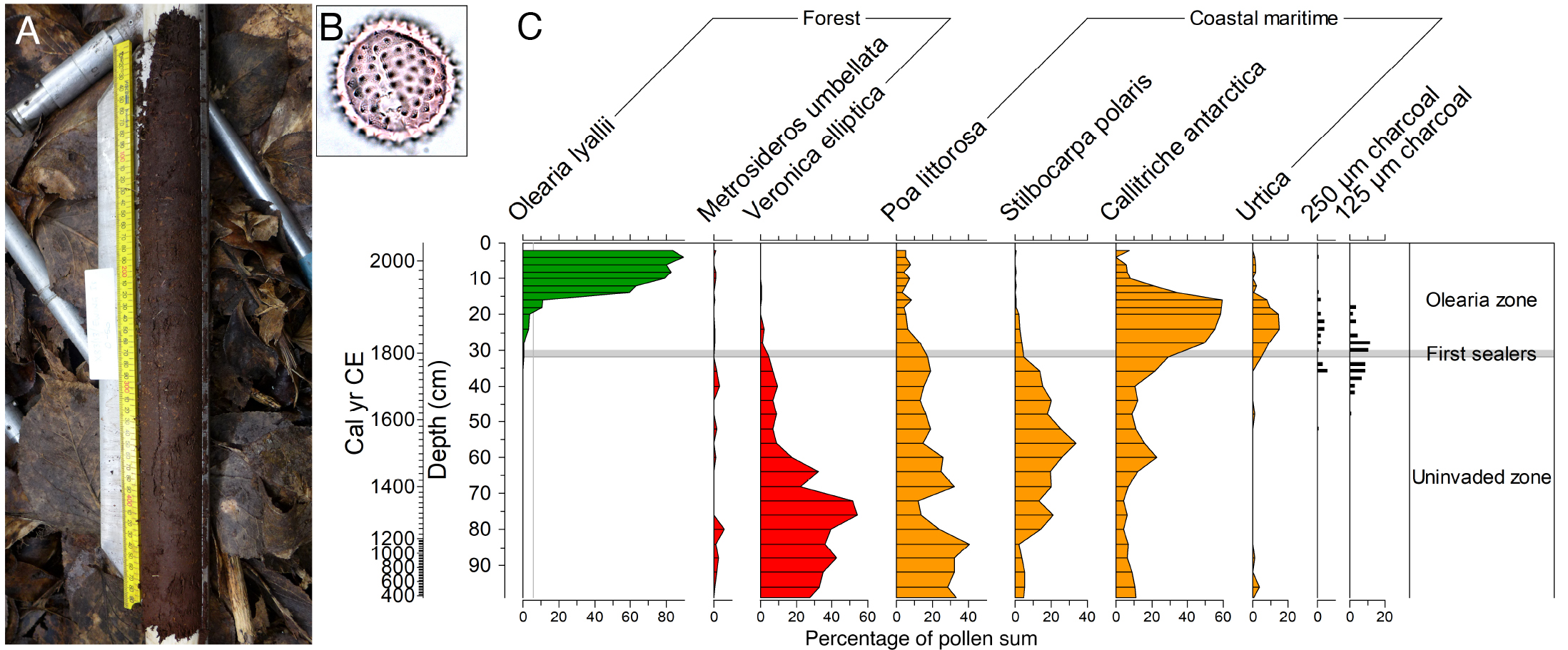- Home
- Publications
- PAGES Magazine
- Paleoecological Records Inform Conservation Management In New Zealand
Paleoecological records inform conservation management in New Zealand
Wilmshurst JM and Wood JR
Past Global Changes Magazine
30(1)
26-27
2022
Pollen and ancient DNA from coprolites and peat reveal new and surprising insights about past pollination, herbivory, and native/alien status in New Zealand. These paleoecological findings help in understanding ecosystem structure and function before human arrival, informing current conservation, restoration, and management issues.
Oceanic islands have been transformed by forest clearance, extinctions, and invasive species following human arrival, leading to the creation of novel ecosystems (Wood et al. 2017; Nogué et al. 2021). This creates challenges for the management of current ecosystems, particularly if only relatively short-term ecological and historical observations are available to estimate what is "natural" on the landscape today (Willis and Birks 2006).
Paleoecology provides a longer-term perspective, and a more scientifically informed and defensible basis for biodiversity management decisions (Willis et al. 2007). Increasingly, paleoecological studies are providing new insights on ecological networks and interactions (e.g. pollination, seed-dispersal, and herbivory), function, and resilience (Dietl 2015), which can increase our understanding of current ecosystems and inform their management (Willis et al. 2007; Johnson et al. 2017). This is important in restoring degraded ecosystems where critical ecological functions have been disrupted.
As with many islands, initial human settlement of New Zealand ca. 1280 CE saw fundamental changes to ecosystems, largely through deforestation by fire and the rapid demise of its bird-dominated fauna (Perry et al. 2014a; Perry et al. 2014b; Wood et al. 2017). Here we showcase three examples from New Zealand where pollen and ancient DNA analyses of coprolites and peat have expanded our understanding about ecological processes and interactions and contributed to debates about contemporary conservation issues, including restoration of pollination, management of herbivores and establishing the native versus alien status of species.
 |
|
Figure 1: (A) Kākāpō (Strigops habroptila) and lesser short-tailed bats (Mystacina tuberculata) consuming nectar from Dactylanthus taylori flowers (from Wood et al. 2012: Artwork credit: Chris Gaskin); (B) Moa coprolite, Dart River Valley, New Zealand (photo credit: J.M. Wilmshurst); (C) Comparison of relative pollen abundance from selected forest understorey plant taxa recorded in individually sampled moa coprolites and deer pellets from Dart River Valley (modified from Wood & Wilmshurst 2019). Deer silhouette by Anthony Caravaggi (CC BY-NC-SA 3.0; creativecommons.org/licenses/by-nc-sa/3.0). |
Restoring ecological interactions: analysis of coprolites uncovers lost pollinators
New Zealand's endemic and threatened Dactylanthus taylori is a cryptic root parasite of hardwood trees and shrubs. Its current range is vastly reduced from its prehuman distribution, due to forest clearance and browsing from introduced possums (Trichosurus vulpecula) and rats (Rattus rattus and R. norvegicus) (Ecroyd 1996). The flowers, the only part of the plant to emerge above ground, produce copious, highly scented, and sticky nectar. The only documented pollinator is the lesser short-tailed bat (Mystacina tuberculata), which forages on the forest floor like a mouse (Fig. 1a). This species is also threatened and it's pre-human distributional range has become greatly reduced in area and highly fragmented (Ecroyd 1996). As Dactylanthus no longer co-occurs with the short-tailed bat in many places, pollination limitation provides a challenge to its conservation (Holzapfel 2005). However, Wood et al. (2012) made a surprise finding of Dactylanthus pollen preserved in a 900-year-old coprolite, which ancient DNA showed as belonging to kākāpō (Strigops habroptila), a threatened, flightless nocturnal parrot (Fig. 1a). This result suggested ground feeding and nectar drinking birds (many now extinct or rare because of mammalian predators) may also have once pollinated Dactylanthus. This new insight now means that besides promoting conditions for the pollinating bat Mystacina tuberculata, establishing Dactylanthus on predator-free islands with nectivorous birds is a possible solution for overcoming pollination limitation in the conservation of this rare plant.
Reconstructing past diets of extinct herbivores to inform current management of introduced herbivores
Before human arrival in New Zealand, the ratite moa were the largest of the terrestrial herbivores. Pollen, macrofossil, and ancient DNA studies of their distinctive coprolites (Fig. 1b) show that these birds browsed widely on trees, shrubs, climbers, herbs, forbs, and ferns (Wood et al. 2020). The extinction of all nine moa species by ca. 1450 CE left the large herbivore niche vacant. The introduction of ungulates from the late 1700s to early 1900s CE, including deer and goats, restored this large herbivore guild to New Zealand. However, there is ongoing debate about whether ungulate browsing is functionally equivalent to moa browsing (Wood and Wilmshurst 2017).
In 2006, coprolites (Fig. 1b) were discovered beneath a rock overhang in the remote Dart River Valley in southern New Zealand. DNA analysis and radiocarbon dating showed that they had been deposited by four different species of moa between 1,000 and 600 years ago (Wood and Wilmshurst 2019). This find was important for two reasons. First, it was within an area of relatively "natural" beech (Nothofagaceae) forest not directly modified by humans. Second, deer pellets beneath the overhang allowed a direct comparison between the diets of moa and deer. The moa coprolites contained a far greater richness of pollen types than deer pellets (Fig. 1c), suggesting that pressure from deer browsing is higher than that of moa browsing, and that deer have depleted the forest understorey of many species (Wood and Wilmshurst 2019). Many palatable plants that were common in the moa coprolites are now only found growing on the tops of enormous boulders which are inaccessible to deer. Pollen analysis of high-resolution radiocarbon dated soil cores from other relatively unmodified forests show that forest understoreys appeared to change little following moa extinction in the absence of deer (Wood and Wilmshurst 2017). These new insights from the past offer a growing scientific basis on which comparisons between extinct and introduced herbivores can be made. There is now little doubt that ungulates need to be managed to keep them at low numbers if vegetation structure and diversity similar to the past is to be maintained.
Using paleoecological records to confirm the status of an alien tree on subantarctic Islands
The longer-term perspective provided by paleoecological records (such as pollen, ancient DNA, and faunal remains in sediments or coprolites) can show if a species is native or alien and can inform decisions over whether control is needed. Wilmshurst et al. (2015) combined long-term paleoecological records from peat cores with historical photographs and documents to resolve the status and origin of a New Zealand native tree daisy (Olearia lyallii) growing on the subantarctic Auckland Islands, located about 450 km south of the main islands of New Zealand. The highly localized distribution of O. lyallii on the Auckland Islands was first noted in 1840, and its appropriate management is debated: should it be regarded as an alien invasive and controlled, or acknowledged as a native species in the Auckland Islands flora? Radiocarbon-dated pollen records from northern Auckland Islands showed that O. lyallii was likely absent until 1807–1810 CE (Fig. 2), which is when European sealing gangs arrived on the Auckland Islands for a brief period of seal exploitation. Sealers working on seabird islands at this time about 270 km to the north, where O. lyallii is naturally dominant, most likely transported the dry feathery seeds on their clothes or equipment to the Auckland Islands during this period. Pollen and charcoal records revealed that O. lyallii populations established and thrived in disturbed coastal areas burnt by the sealers (fig. 2). O. lyallii growth was enhanced by nesting seabirds and recovering seal populations using these sites, as the marine nutrients they provided replicated the situation on seabird islands in their natural range. This finding provided conservation managers with a scientifically informed basis to manage O. lyallii as an alien on the Auckland Islands.
Final remarks
Paleoecology can provide critical guidance for conservation management and restoration, especially in situations where other historical information or long-term ecological studies are lacking. It is therefore particularly well suited for recently settled or remote (e.g. oceanic islands) locations. However, even in ecosystems considered well-understood, it can add another dimension by revealing surprising new insights and interactions. The information can be applied in the context of functional re-wilding, herbivore management, and the control of alien species.
affiliations
1Manaaki Whenua – Landcare Research, Lincoln, New Zealand
2School of Environment, University of Auckland, New Zealand
contact
Janet M. Wilmshurst: wilmshurstj landcareresearch.co.nz
landcareresearch.co.nz
references
Dietl G et al. (2015) Ann Rev Earth Planet Sci 43: 79-103
Ecroyd CE (1996) N Z J Ecol 20: 81-100
Johnson CN et al. (2017) Science 356: 270-275
Nogué S et al. (2021) Science 372: 488-491
Perry GLW et al. (2014a) N Z J Ecol 38: 157-176
Perry GLW et al. (2014b) Quat Sci Rev 105: 126-135
Willis KJ et al. (2007) Philos Trans R Soc Lond B Biol Sci 362: 175-186
Willis KJ, Birks HJB (2006) Science 314: 1261-1265
Wilmshurst JM et al. (2015) AoB PLANTS 7: plv104
Wood JR et al. (2017) Environ Conserv 44: 348-358
Wood JR et al. (2020) N Z J Ecol 44: 1-21
Wood JR, Wilmshurst JM (2017) J Veg Sci 28: 160-171
